University Assignment: LAWS20058 Australian Commercial Law Case Study
VerifiedAdded on 2022/11/04
|12
|2365
|237
Case Study
AI Summary
This assignment is a comprehensive case study analyzing various aspects of Australian commercial law. Part A focuses on contract law, examining legal intention, misrepresentation, and the validity of a restraint of trade clause between cousins. Part B delves into the Australian Consumer Law, assessing potential actions Sally can take against a medical company for providing negligent advice and breaching consumer guarantees. Part C explores the tort of negligence, evaluating whether Sally can sue David for an accident on his property, considering duty of care, breach, causation, and damages under common law and state legislation. The analysis includes relevant case law and legislation to support the conclusions reached in each section, offering a detailed exploration of commercial law principles.
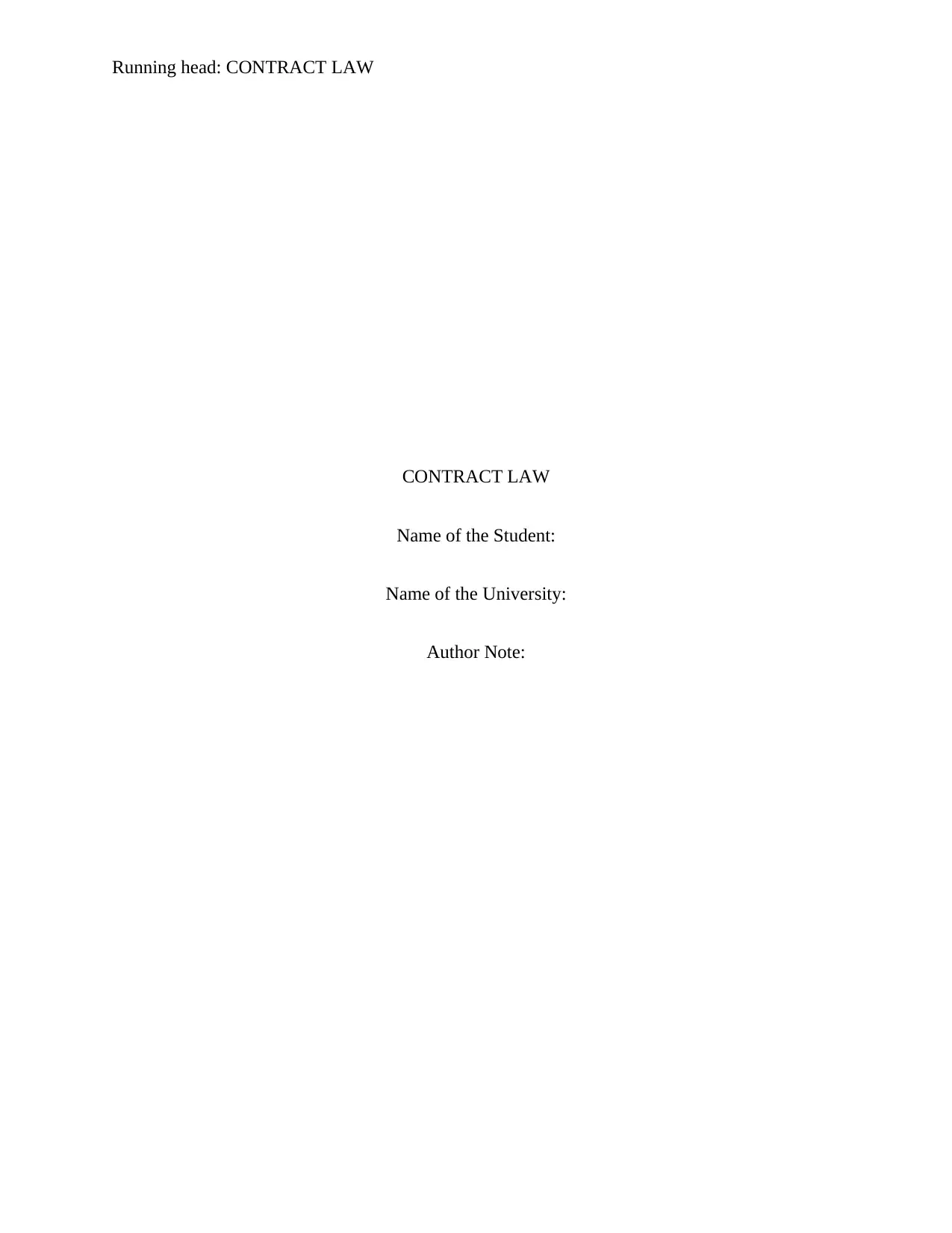
Running head: CONTRACT LAW
CONTRACT LAW
Name of the Student:
Name of the University:
Author Note:
CONTRACT LAW
Name of the Student:
Name of the University:
Author Note:
Paraphrase This Document
Need a fresh take? Get an instant paraphrase of this document with our AI Paraphraser
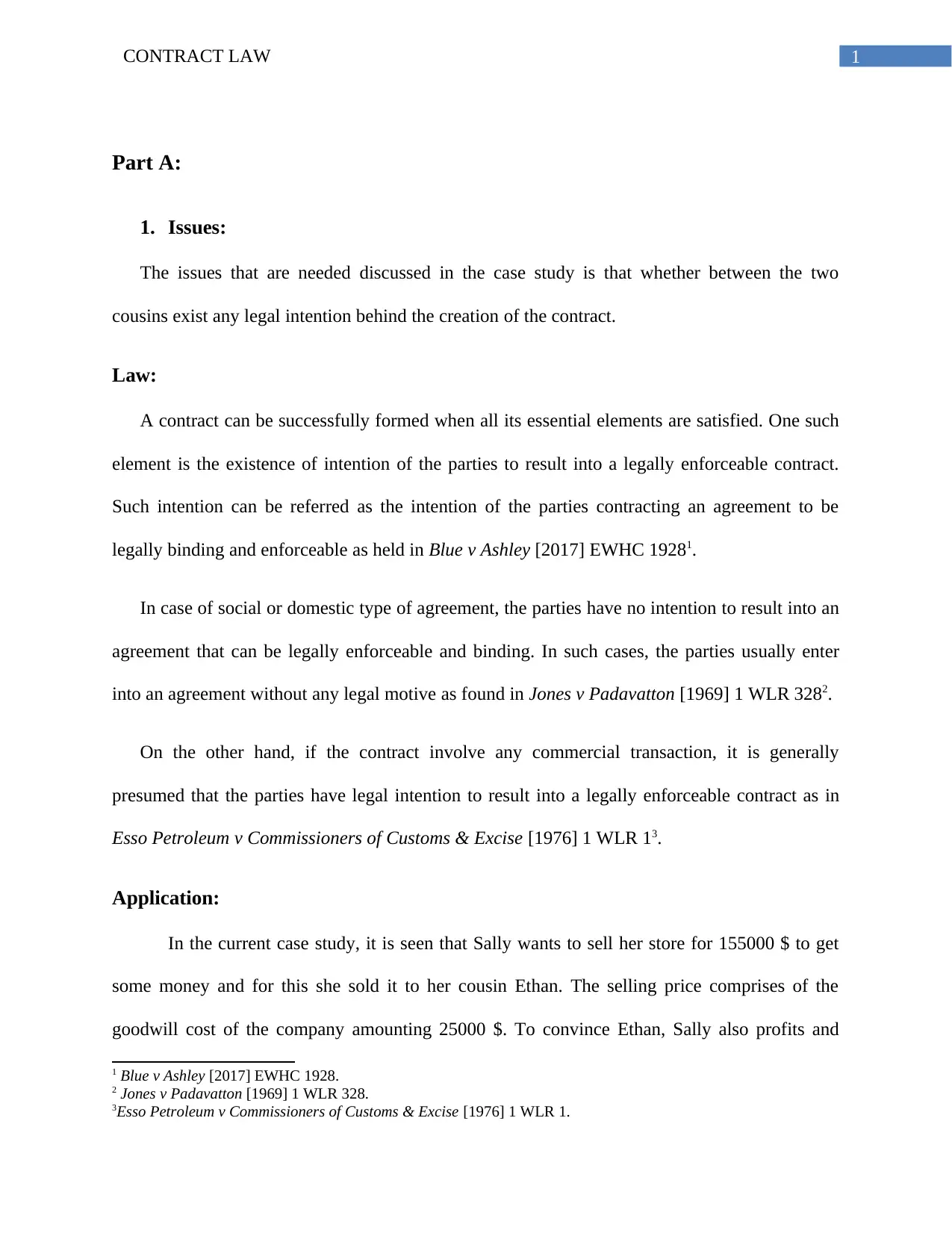
1CONTRACT LAW
Part A:
1. Issues:
The issues that are needed discussed in the case study is that whether between the two
cousins exist any legal intention behind the creation of the contract.
Law:
A contract can be successfully formed when all its essential elements are satisfied. One such
element is the existence of intention of the parties to result into a legally enforceable contract.
Such intention can be referred as the intention of the parties contracting an agreement to be
legally binding and enforceable as held in Blue v Ashley [2017] EWHC 19281.
In case of social or domestic type of agreement, the parties have no intention to result into an
agreement that can be legally enforceable and binding. In such cases, the parties usually enter
into an agreement without any legal motive as found in Jones v Padavatton [1969] 1 WLR 3282.
On the other hand, if the contract involve any commercial transaction, it is generally
presumed that the parties have legal intention to result into a legally enforceable contract as in
Esso Petroleum v Commissioners of Customs & Excise [1976] 1 WLR 13.
Application:
In the current case study, it is seen that Sally wants to sell her store for 155000 $ to get
some money and for this she sold it to her cousin Ethan. The selling price comprises of the
goodwill cost of the company amounting 25000 $. To convince Ethan, Sally also profits and
1 Blue v Ashley [2017] EWHC 1928.
2 Jones v Padavatton [1969] 1 WLR 328.
3Esso Petroleum v Commissioners of Customs & Excise [1976] 1 WLR 1.
Part A:
1. Issues:
The issues that are needed discussed in the case study is that whether between the two
cousins exist any legal intention behind the creation of the contract.
Law:
A contract can be successfully formed when all its essential elements are satisfied. One such
element is the existence of intention of the parties to result into a legally enforceable contract.
Such intention can be referred as the intention of the parties contracting an agreement to be
legally binding and enforceable as held in Blue v Ashley [2017] EWHC 19281.
In case of social or domestic type of agreement, the parties have no intention to result into an
agreement that can be legally enforceable and binding. In such cases, the parties usually enter
into an agreement without any legal motive as found in Jones v Padavatton [1969] 1 WLR 3282.
On the other hand, if the contract involve any commercial transaction, it is generally
presumed that the parties have legal intention to result into a legally enforceable contract as in
Esso Petroleum v Commissioners of Customs & Excise [1976] 1 WLR 13.
Application:
In the current case study, it is seen that Sally wants to sell her store for 155000 $ to get
some money and for this she sold it to her cousin Ethan. The selling price comprises of the
goodwill cost of the company amounting 25000 $. To convince Ethan, Sally also profits and
1 Blue v Ashley [2017] EWHC 1928.
2 Jones v Padavatton [1969] 1 WLR 328.
3Esso Petroleum v Commissioners of Customs & Excise [1976] 1 WLR 1.
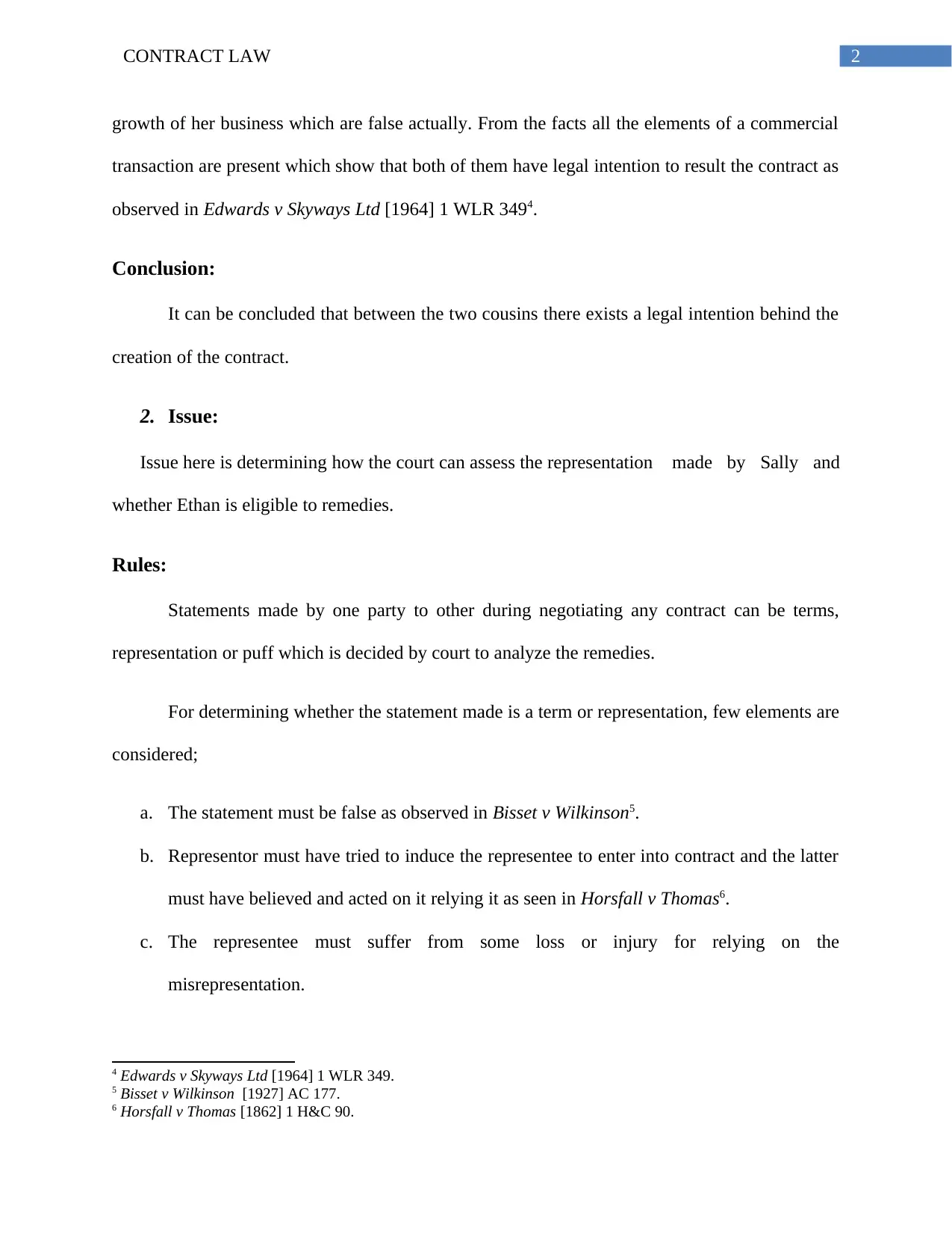
2CONTRACT LAW
growth of her business which are false actually. From the facts all the elements of a commercial
transaction are present which show that both of them have legal intention to result the contract as
observed in Edwards v Skyways Ltd [1964] 1 WLR 3494.
Conclusion:
It can be concluded that between the two cousins there exists a legal intention behind the
creation of the contract.
2. Issue:
Issue here is determining how the court can assess the representation made by Sally and
whether Ethan is eligible to remedies.
Rules:
Statements made by one party to other during negotiating any contract can be terms,
representation or puff which is decided by court to analyze the remedies.
For determining whether the statement made is a term or representation, few elements are
considered;
a. The statement must be false as observed in Bisset v Wilkinson5.
b. Representor must have tried to induce the representee to enter into contract and the latter
must have believed and acted on it relying it as seen in Horsfall v Thomas6.
c. The representee must suffer from some loss or injury for relying on the
misrepresentation.
4 Edwards v Skyways Ltd [1964] 1 WLR 349.
5 Bisset v Wilkinson [1927] AC 177.
6 Horsfall v Thomas [1862] 1 H&C 90.
growth of her business which are false actually. From the facts all the elements of a commercial
transaction are present which show that both of them have legal intention to result the contract as
observed in Edwards v Skyways Ltd [1964] 1 WLR 3494.
Conclusion:
It can be concluded that between the two cousins there exists a legal intention behind the
creation of the contract.
2. Issue:
Issue here is determining how the court can assess the representation made by Sally and
whether Ethan is eligible to remedies.
Rules:
Statements made by one party to other during negotiating any contract can be terms,
representation or puff which is decided by court to analyze the remedies.
For determining whether the statement made is a term or representation, few elements are
considered;
a. The statement must be false as observed in Bisset v Wilkinson5.
b. Representor must have tried to induce the representee to enter into contract and the latter
must have believed and acted on it relying it as seen in Horsfall v Thomas6.
c. The representee must suffer from some loss or injury for relying on the
misrepresentation.
4 Edwards v Skyways Ltd [1964] 1 WLR 349.
5 Bisset v Wilkinson [1927] AC 177.
6 Horsfall v Thomas [1862] 1 H&C 90.
⊘ This is a preview!⊘
Do you want full access?
Subscribe today to unlock all pages.

Trusted by 1+ million students worldwide
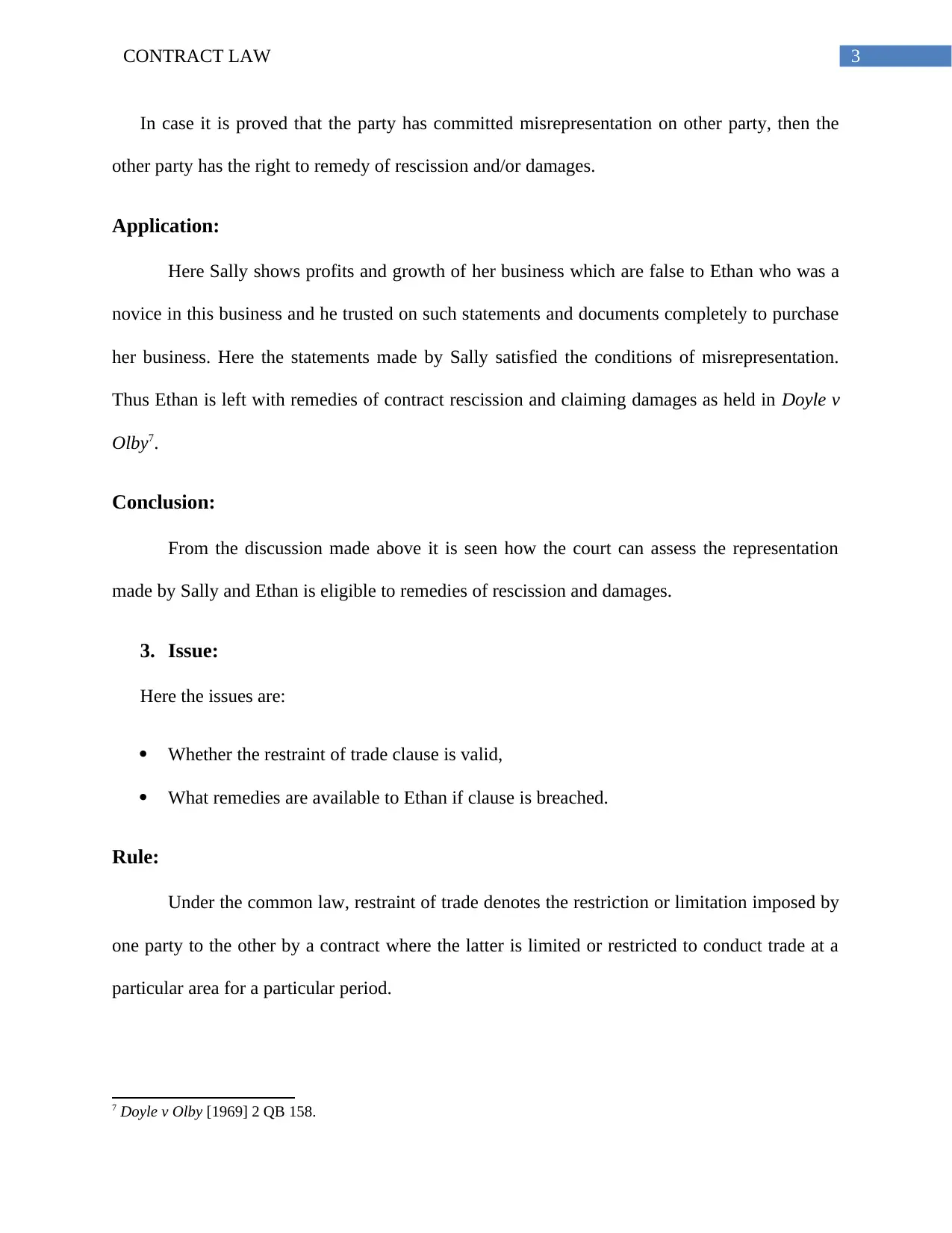
3CONTRACT LAW
In case it is proved that the party has committed misrepresentation on other party, then the
other party has the right to remedy of rescission and/or damages.
Application:
Here Sally shows profits and growth of her business which are false to Ethan who was a
novice in this business and he trusted on such statements and documents completely to purchase
her business. Here the statements made by Sally satisfied the conditions of misrepresentation.
Thus Ethan is left with remedies of contract rescission and claiming damages as held in Doyle v
Olby7.
Conclusion:
From the discussion made above it is seen how the court can assess the representation
made by Sally and Ethan is eligible to remedies of rescission and damages.
3. Issue:
Here the issues are:
Whether the restraint of trade clause is valid,
What remedies are available to Ethan if clause is breached.
Rule:
Under the common law, restraint of trade denotes the restriction or limitation imposed by
one party to the other by a contract where the latter is limited or restricted to conduct trade at a
particular area for a particular period.
7 Doyle v Olby [1969] 2 QB 158.
In case it is proved that the party has committed misrepresentation on other party, then the
other party has the right to remedy of rescission and/or damages.
Application:
Here Sally shows profits and growth of her business which are false to Ethan who was a
novice in this business and he trusted on such statements and documents completely to purchase
her business. Here the statements made by Sally satisfied the conditions of misrepresentation.
Thus Ethan is left with remedies of contract rescission and claiming damages as held in Doyle v
Olby7.
Conclusion:
From the discussion made above it is seen how the court can assess the representation
made by Sally and Ethan is eligible to remedies of rescission and damages.
3. Issue:
Here the issues are:
Whether the restraint of trade clause is valid,
What remedies are available to Ethan if clause is breached.
Rule:
Under the common law, restraint of trade denotes the restriction or limitation imposed by
one party to the other by a contract where the latter is limited or restricted to conduct trade at a
particular area for a particular period.
7 Doyle v Olby [1969] 2 QB 158.
Paraphrase This Document
Need a fresh take? Get an instant paraphrase of this document with our AI Paraphraser
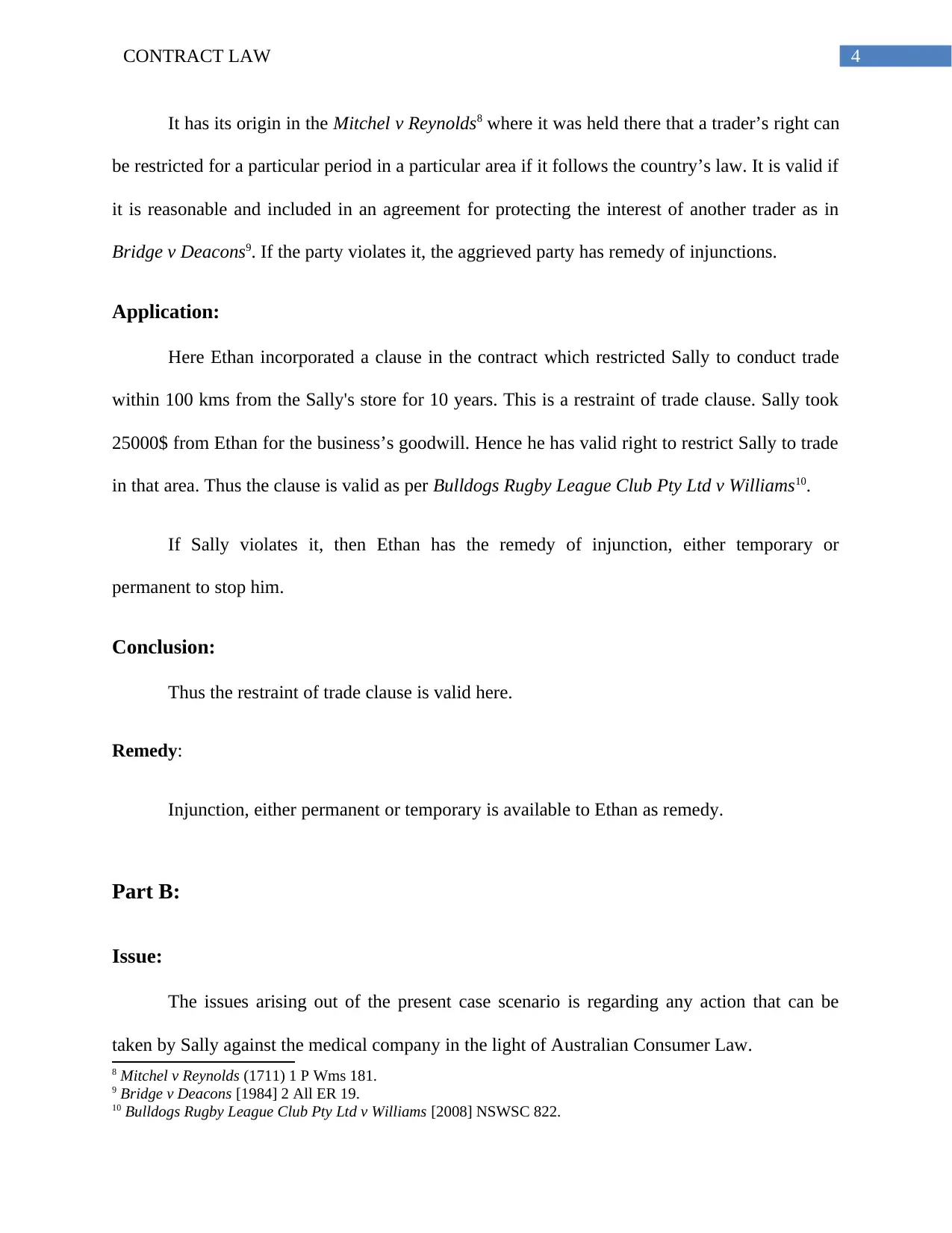
4CONTRACT LAW
It has its origin in the Mitchel v Reynolds8 where it was held there that a trader’s right can
be restricted for a particular period in a particular area if it follows the country’s law. It is valid if
it is reasonable and included in an agreement for protecting the interest of another trader as in
Bridge v Deacons9. If the party violates it, the aggrieved party has remedy of injunctions.
Application:
Here Ethan incorporated a clause in the contract which restricted Sally to conduct trade
within 100 kms from the Sally's store for 10 years. This is a restraint of trade clause. Sally took
25000$ from Ethan for the business’s goodwill. Hence he has valid right to restrict Sally to trade
in that area. Thus the clause is valid as per Bulldogs Rugby League Club Pty Ltd v Williams10.
If Sally violates it, then Ethan has the remedy of injunction, either temporary or
permanent to stop him.
Conclusion:
Thus the restraint of trade clause is valid here.
Remedy:
Injunction, either permanent or temporary is available to Ethan as remedy.
Part B:
Issue:
The issues arising out of the present case scenario is regarding any action that can be
taken by Sally against the medical company in the light of Australian Consumer Law.
8 Mitchel v Reynolds (1711) 1 P Wms 181.
9 Bridge v Deacons [1984] 2 All ER 19.
10 Bulldogs Rugby League Club Pty Ltd v Williams [2008] NSWSC 822.
It has its origin in the Mitchel v Reynolds8 where it was held there that a trader’s right can
be restricted for a particular period in a particular area if it follows the country’s law. It is valid if
it is reasonable and included in an agreement for protecting the interest of another trader as in
Bridge v Deacons9. If the party violates it, the aggrieved party has remedy of injunctions.
Application:
Here Ethan incorporated a clause in the contract which restricted Sally to conduct trade
within 100 kms from the Sally's store for 10 years. This is a restraint of trade clause. Sally took
25000$ from Ethan for the business’s goodwill. Hence he has valid right to restrict Sally to trade
in that area. Thus the clause is valid as per Bulldogs Rugby League Club Pty Ltd v Williams10.
If Sally violates it, then Ethan has the remedy of injunction, either temporary or
permanent to stop him.
Conclusion:
Thus the restraint of trade clause is valid here.
Remedy:
Injunction, either permanent or temporary is available to Ethan as remedy.
Part B:
Issue:
The issues arising out of the present case scenario is regarding any action that can be
taken by Sally against the medical company in the light of Australian Consumer Law.
8 Mitchel v Reynolds (1711) 1 P Wms 181.
9 Bridge v Deacons [1984] 2 All ER 19.
10 Bulldogs Rugby League Club Pty Ltd v Williams [2008] NSWSC 822.
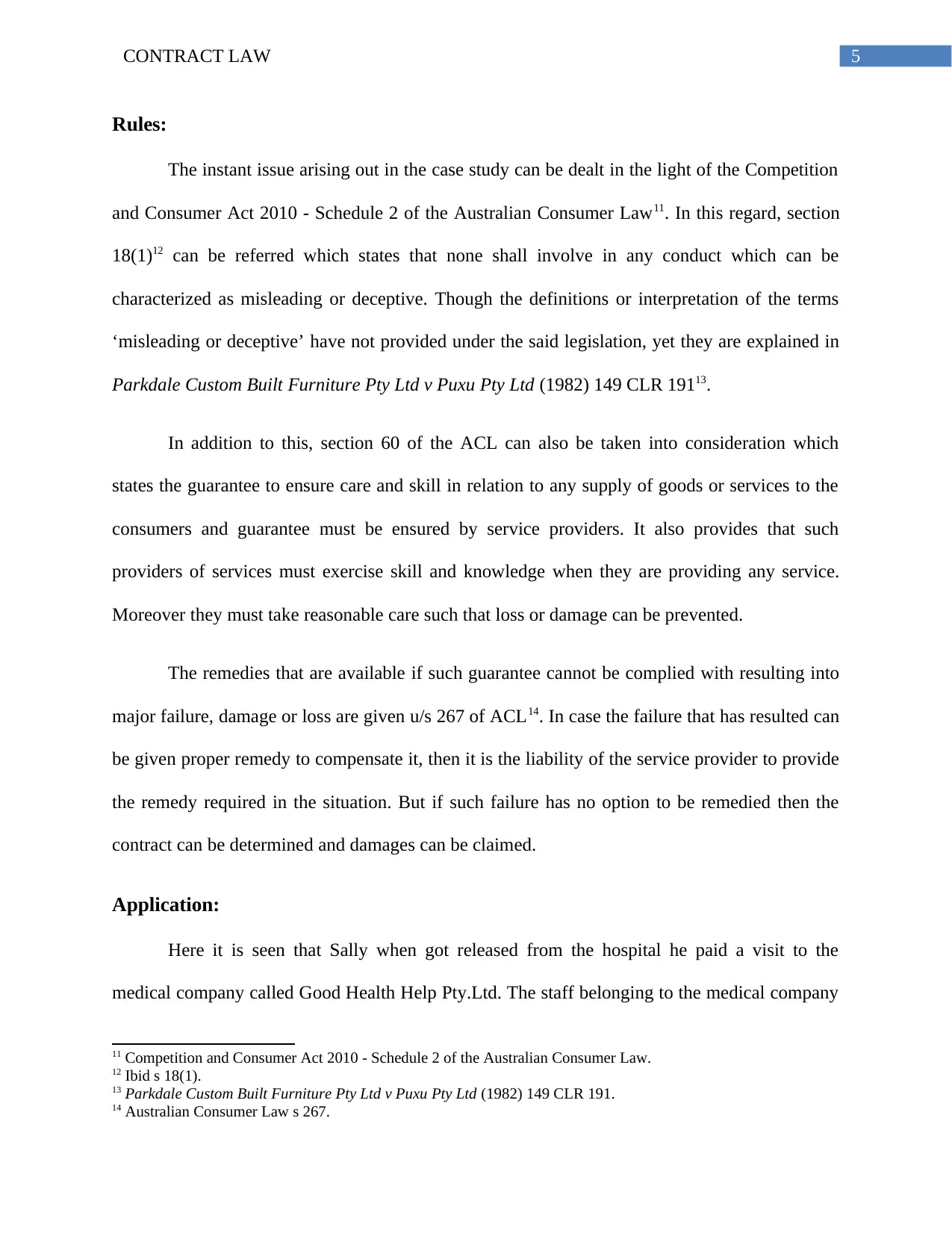
5CONTRACT LAW
Rules:
The instant issue arising out in the case study can be dealt in the light of the Competition
and Consumer Act 2010 - Schedule 2 of the Australian Consumer Law11. In this regard, section
18(1)12 can be referred which states that none shall involve in any conduct which can be
characterized as misleading or deceptive. Though the definitions or interpretation of the terms
‘misleading or deceptive’ have not provided under the said legislation, yet they are explained in
Parkdale Custom Built Furniture Pty Ltd v Puxu Pty Ltd (1982) 149 CLR 19113.
In addition to this, section 60 of the ACL can also be taken into consideration which
states the guarantee to ensure care and skill in relation to any supply of goods or services to the
consumers and guarantee must be ensured by service providers. It also provides that such
providers of services must exercise skill and knowledge when they are providing any service.
Moreover they must take reasonable care such that loss or damage can be prevented.
The remedies that are available if such guarantee cannot be complied with resulting into
major failure, damage or loss are given u/s 267 of ACL14. In case the failure that has resulted can
be given proper remedy to compensate it, then it is the liability of the service provider to provide
the remedy required in the situation. But if such failure has no option to be remedied then the
contract can be determined and damages can be claimed.
Application:
Here it is seen that Sally when got released from the hospital he paid a visit to the
medical company called Good Health Help Pty.Ltd. The staff belonging to the medical company
11 Competition and Consumer Act 2010 - Schedule 2 of the Australian Consumer Law.
12 Ibid s 18(1).
13 Parkdale Custom Built Furniture Pty Ltd v Puxu Pty Ltd (1982) 149 CLR 191.
14 Australian Consumer Law s 267.
Rules:
The instant issue arising out in the case study can be dealt in the light of the Competition
and Consumer Act 2010 - Schedule 2 of the Australian Consumer Law11. In this regard, section
18(1)12 can be referred which states that none shall involve in any conduct which can be
characterized as misleading or deceptive. Though the definitions or interpretation of the terms
‘misleading or deceptive’ have not provided under the said legislation, yet they are explained in
Parkdale Custom Built Furniture Pty Ltd v Puxu Pty Ltd (1982) 149 CLR 19113.
In addition to this, section 60 of the ACL can also be taken into consideration which
states the guarantee to ensure care and skill in relation to any supply of goods or services to the
consumers and guarantee must be ensured by service providers. It also provides that such
providers of services must exercise skill and knowledge when they are providing any service.
Moreover they must take reasonable care such that loss or damage can be prevented.
The remedies that are available if such guarantee cannot be complied with resulting into
major failure, damage or loss are given u/s 267 of ACL14. In case the failure that has resulted can
be given proper remedy to compensate it, then it is the liability of the service provider to provide
the remedy required in the situation. But if such failure has no option to be remedied then the
contract can be determined and damages can be claimed.
Application:
Here it is seen that Sally when got released from the hospital he paid a visit to the
medical company called Good Health Help Pty.Ltd. The staff belonging to the medical company
11 Competition and Consumer Act 2010 - Schedule 2 of the Australian Consumer Law.
12 Ibid s 18(1).
13 Parkdale Custom Built Furniture Pty Ltd v Puxu Pty Ltd (1982) 149 CLR 191.
14 Australian Consumer Law s 267.
⊘ This is a preview!⊘
Do you want full access?
Subscribe today to unlock all pages.

Trusted by 1+ million students worldwide
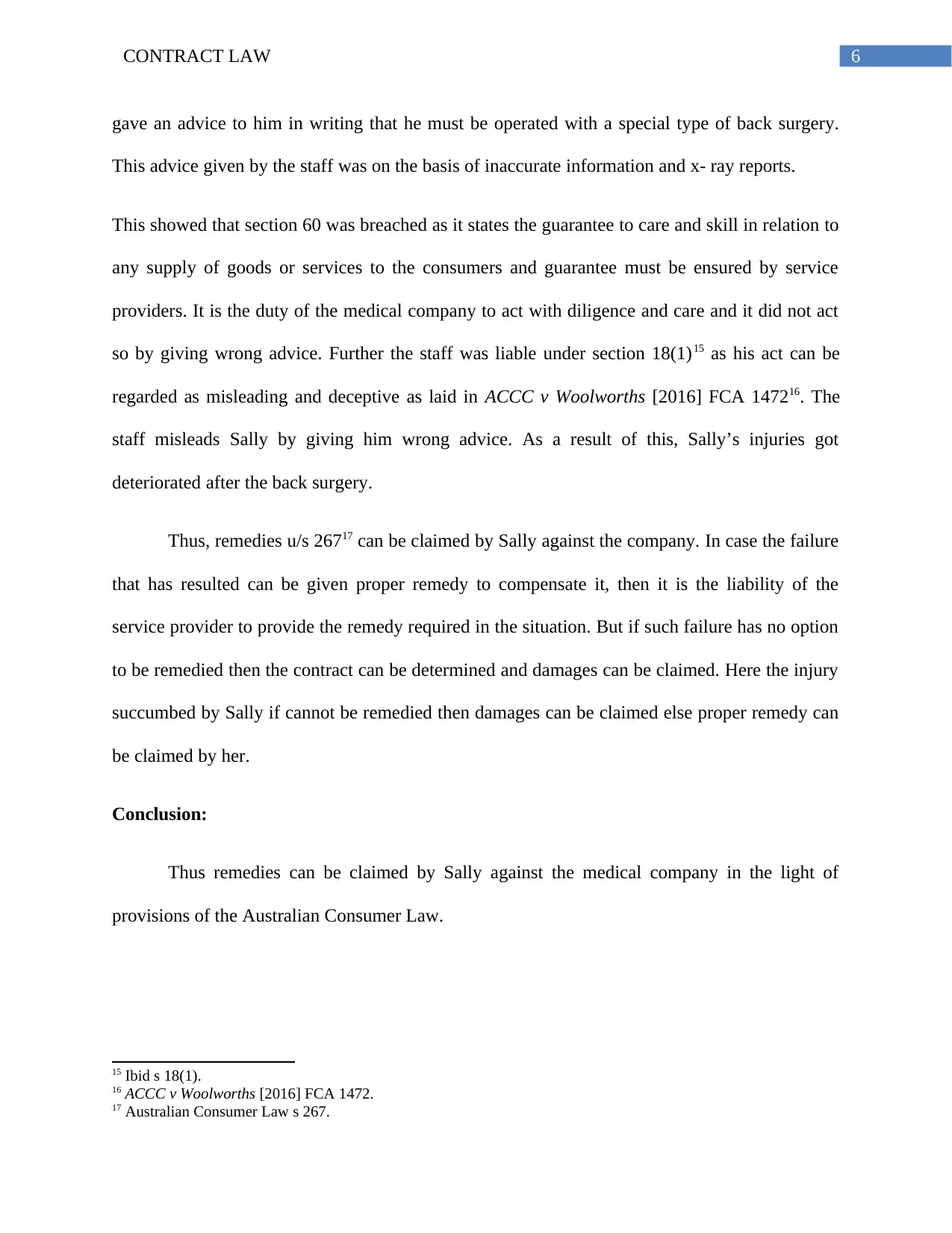
6CONTRACT LAW
gave an advice to him in writing that he must be operated with a special type of back surgery.
This advice given by the staff was on the basis of inaccurate information and x- ray reports.
This showed that section 60 was breached as it states the guarantee to care and skill in relation to
any supply of goods or services to the consumers and guarantee must be ensured by service
providers. It is the duty of the medical company to act with diligence and care and it did not act
so by giving wrong advice. Further the staff was liable under section 18(1)15 as his act can be
regarded as misleading and deceptive as laid in ACCC v Woolworths [2016] FCA 147216. The
staff misleads Sally by giving him wrong advice. As a result of this, Sally’s injuries got
deteriorated after the back surgery.
Thus, remedies u/s 26717 can be claimed by Sally against the company. In case the failure
that has resulted can be given proper remedy to compensate it, then it is the liability of the
service provider to provide the remedy required in the situation. But if such failure has no option
to be remedied then the contract can be determined and damages can be claimed. Here the injury
succumbed by Sally if cannot be remedied then damages can be claimed else proper remedy can
be claimed by her.
Conclusion:
Thus remedies can be claimed by Sally against the medical company in the light of
provisions of the Australian Consumer Law.
15 Ibid s 18(1).
16 ACCC v Woolworths [2016] FCA 1472.
17 Australian Consumer Law s 267.
gave an advice to him in writing that he must be operated with a special type of back surgery.
This advice given by the staff was on the basis of inaccurate information and x- ray reports.
This showed that section 60 was breached as it states the guarantee to care and skill in relation to
any supply of goods or services to the consumers and guarantee must be ensured by service
providers. It is the duty of the medical company to act with diligence and care and it did not act
so by giving wrong advice. Further the staff was liable under section 18(1)15 as his act can be
regarded as misleading and deceptive as laid in ACCC v Woolworths [2016] FCA 147216. The
staff misleads Sally by giving him wrong advice. As a result of this, Sally’s injuries got
deteriorated after the back surgery.
Thus, remedies u/s 26717 can be claimed by Sally against the company. In case the failure
that has resulted can be given proper remedy to compensate it, then it is the liability of the
service provider to provide the remedy required in the situation. But if such failure has no option
to be remedied then the contract can be determined and damages can be claimed. Here the injury
succumbed by Sally if cannot be remedied then damages can be claimed else proper remedy can
be claimed by her.
Conclusion:
Thus remedies can be claimed by Sally against the medical company in the light of
provisions of the Australian Consumer Law.
15 Ibid s 18(1).
16 ACCC v Woolworths [2016] FCA 1472.
17 Australian Consumer Law s 267.
Paraphrase This Document
Need a fresh take? Get an instant paraphrase of this document with our AI Paraphraser
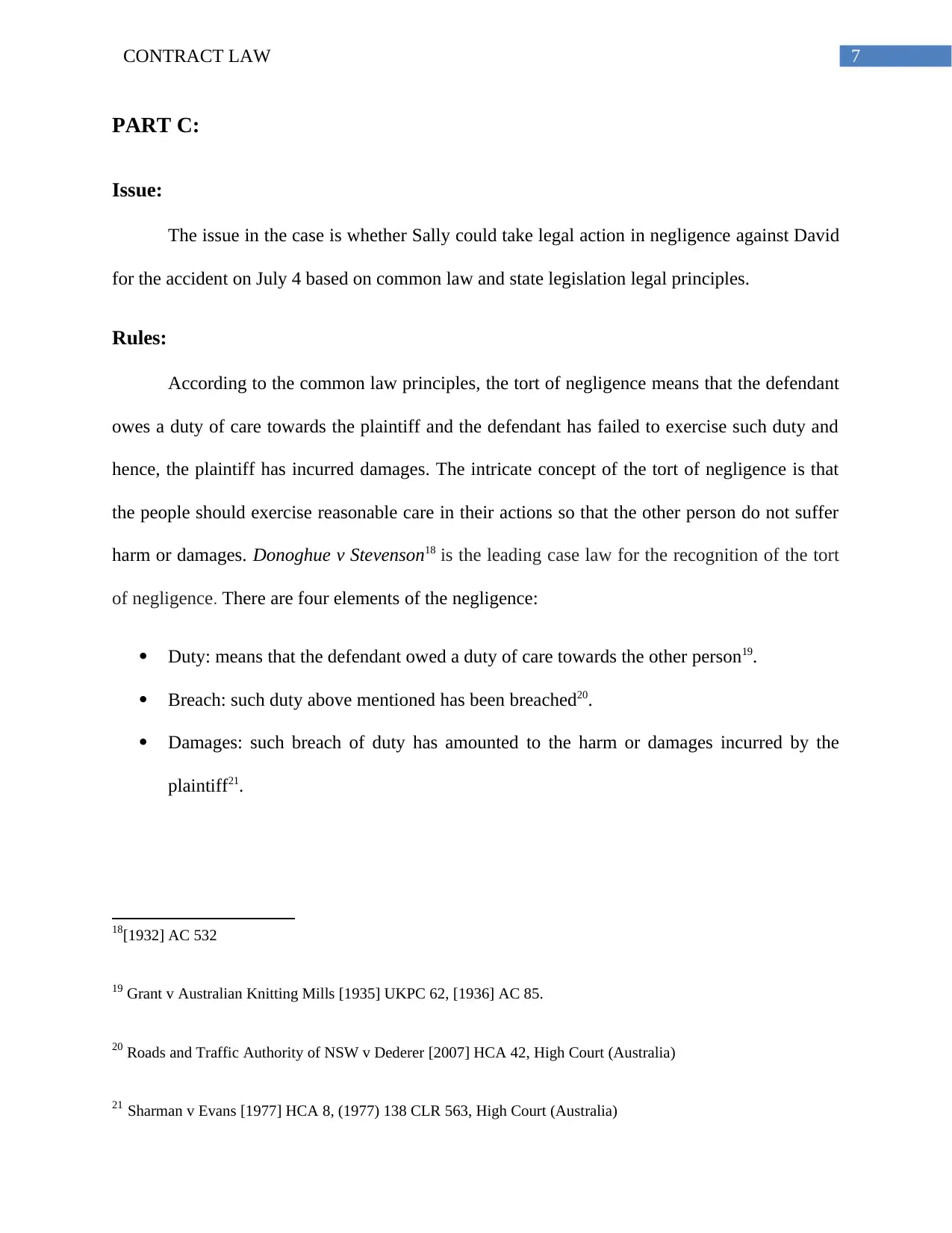
7CONTRACT LAW
PART C:
Issue:
The issue in the case is whether Sally could take legal action in negligence against David
for the accident on July 4 based on common law and state legislation legal principles.
Rules:
According to the common law principles, the tort of negligence means that the defendant
owes a duty of care towards the plaintiff and the defendant has failed to exercise such duty and
hence, the plaintiff has incurred damages. The intricate concept of the tort of negligence is that
the people should exercise reasonable care in their actions so that the other person do not suffer
harm or damages. Donoghue v Stevenson18 is the leading case law for the recognition of the tort
of negligence. There are four elements of the negligence:
Duty: means that the defendant owed a duty of care towards the other person19.
Breach: such duty above mentioned has been breached20.
Damages: such breach of duty has amounted to the harm or damages incurred by the
plaintiff21.
18[1932] AC 532
19 Grant v Australian Knitting Mills [1935] UKPC 62, [1936] AC 85.
20 Roads and Traffic Authority of NSW v Dederer [2007] HCA 42, High Court (Australia)
21 Sharman v Evans [1977] HCA 8, (1977) 138 CLR 563, High Court (Australia)
PART C:
Issue:
The issue in the case is whether Sally could take legal action in negligence against David
for the accident on July 4 based on common law and state legislation legal principles.
Rules:
According to the common law principles, the tort of negligence means that the defendant
owes a duty of care towards the plaintiff and the defendant has failed to exercise such duty and
hence, the plaintiff has incurred damages. The intricate concept of the tort of negligence is that
the people should exercise reasonable care in their actions so that the other person do not suffer
harm or damages. Donoghue v Stevenson18 is the leading case law for the recognition of the tort
of negligence. There are four elements of the negligence:
Duty: means that the defendant owed a duty of care towards the other person19.
Breach: such duty above mentioned has been breached20.
Damages: such breach of duty has amounted to the harm or damages incurred by the
plaintiff21.
18[1932] AC 532
19 Grant v Australian Knitting Mills [1935] UKPC 62, [1936] AC 85.
20 Roads and Traffic Authority of NSW v Dederer [2007] HCA 42, High Court (Australia)
21 Sharman v Evans [1977] HCA 8, (1977) 138 CLR 563, High Court (Australia)
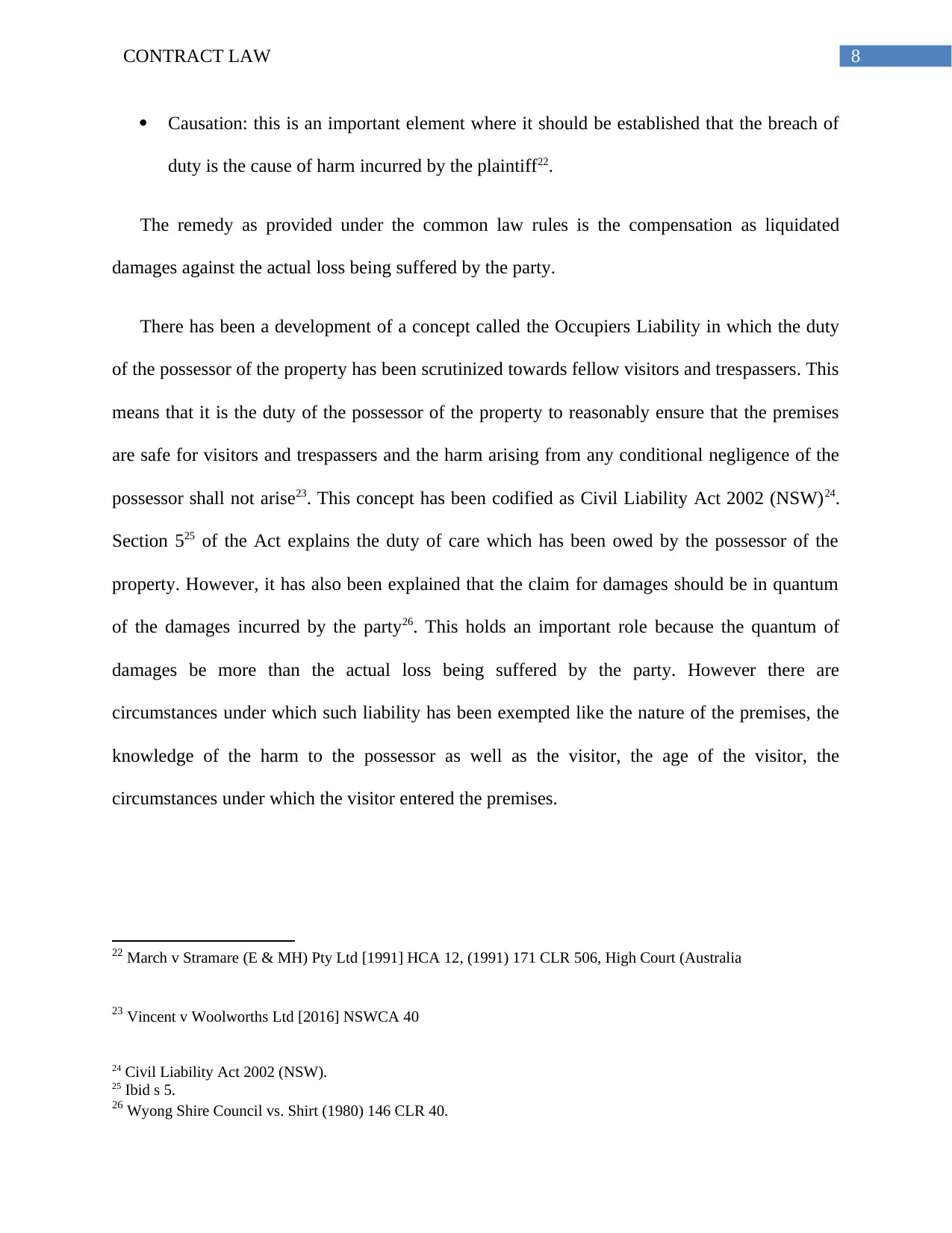
8CONTRACT LAW
Causation: this is an important element where it should be established that the breach of
duty is the cause of harm incurred by the plaintiff22.
The remedy as provided under the common law rules is the compensation as liquidated
damages against the actual loss being suffered by the party.
There has been a development of a concept called the Occupiers Liability in which the duty
of the possessor of the property has been scrutinized towards fellow visitors and trespassers. This
means that it is the duty of the possessor of the property to reasonably ensure that the premises
are safe for visitors and trespassers and the harm arising from any conditional negligence of the
possessor shall not arise23. This concept has been codified as Civil Liability Act 2002 (NSW)24.
Section 525 of the Act explains the duty of care which has been owed by the possessor of the
property. However, it has also been explained that the claim for damages should be in quantum
of the damages incurred by the party26. This holds an important role because the quantum of
damages be more than the actual loss being suffered by the party. However there are
circumstances under which such liability has been exempted like the nature of the premises, the
knowledge of the harm to the possessor as well as the visitor, the age of the visitor, the
circumstances under which the visitor entered the premises.
22 March v Stramare (E & MH) Pty Ltd [1991] HCA 12, (1991) 171 CLR 506, High Court (Australia
23 Vincent v Woolworths Ltd [2016] NSWCA 40
24 Civil Liability Act 2002 (NSW).
25 Ibid s 5.
26 Wyong Shire Council vs. Shirt (1980) 146 CLR 40.
Causation: this is an important element where it should be established that the breach of
duty is the cause of harm incurred by the plaintiff22.
The remedy as provided under the common law rules is the compensation as liquidated
damages against the actual loss being suffered by the party.
There has been a development of a concept called the Occupiers Liability in which the duty
of the possessor of the property has been scrutinized towards fellow visitors and trespassers. This
means that it is the duty of the possessor of the property to reasonably ensure that the premises
are safe for visitors and trespassers and the harm arising from any conditional negligence of the
possessor shall not arise23. This concept has been codified as Civil Liability Act 2002 (NSW)24.
Section 525 of the Act explains the duty of care which has been owed by the possessor of the
property. However, it has also been explained that the claim for damages should be in quantum
of the damages incurred by the party26. This holds an important role because the quantum of
damages be more than the actual loss being suffered by the party. However there are
circumstances under which such liability has been exempted like the nature of the premises, the
knowledge of the harm to the possessor as well as the visitor, the age of the visitor, the
circumstances under which the visitor entered the premises.
22 March v Stramare (E & MH) Pty Ltd [1991] HCA 12, (1991) 171 CLR 506, High Court (Australia
23 Vincent v Woolworths Ltd [2016] NSWCA 40
24 Civil Liability Act 2002 (NSW).
25 Ibid s 5.
26 Wyong Shire Council vs. Shirt (1980) 146 CLR 40.
⊘ This is a preview!⊘
Do you want full access?
Subscribe today to unlock all pages.

Trusted by 1+ million students worldwide
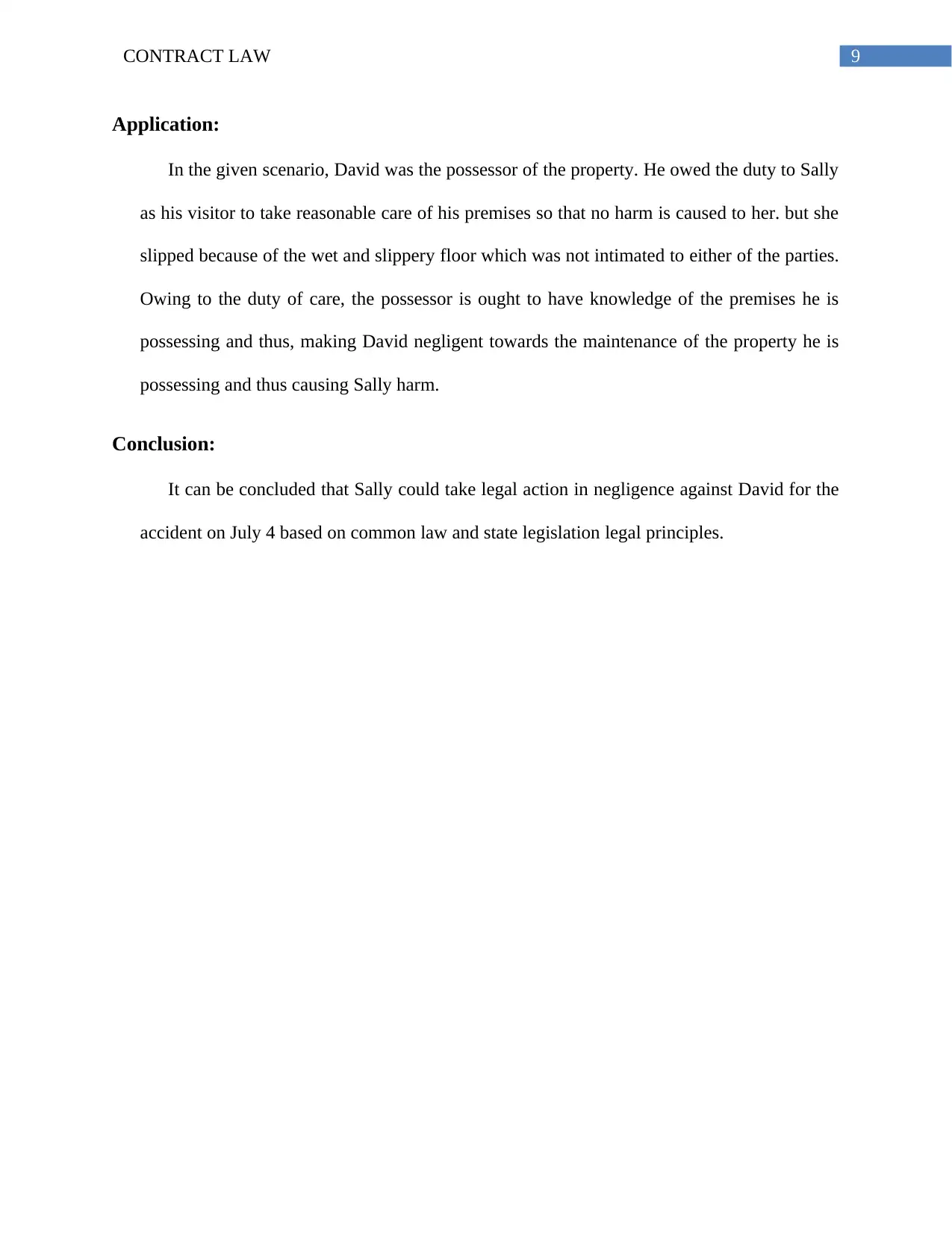
9CONTRACT LAW
Application:
In the given scenario, David was the possessor of the property. He owed the duty to Sally
as his visitor to take reasonable care of his premises so that no harm is caused to her. but she
slipped because of the wet and slippery floor which was not intimated to either of the parties.
Owing to the duty of care, the possessor is ought to have knowledge of the premises he is
possessing and thus, making David negligent towards the maintenance of the property he is
possessing and thus causing Sally harm.
Conclusion:
It can be concluded that Sally could take legal action in negligence against David for the
accident on July 4 based on common law and state legislation legal principles.
Application:
In the given scenario, David was the possessor of the property. He owed the duty to Sally
as his visitor to take reasonable care of his premises so that no harm is caused to her. but she
slipped because of the wet and slippery floor which was not intimated to either of the parties.
Owing to the duty of care, the possessor is ought to have knowledge of the premises he is
possessing and thus, making David negligent towards the maintenance of the property he is
possessing and thus causing Sally harm.
Conclusion:
It can be concluded that Sally could take legal action in negligence against David for the
accident on July 4 based on common law and state legislation legal principles.
Paraphrase This Document
Need a fresh take? Get an instant paraphrase of this document with our AI Paraphraser
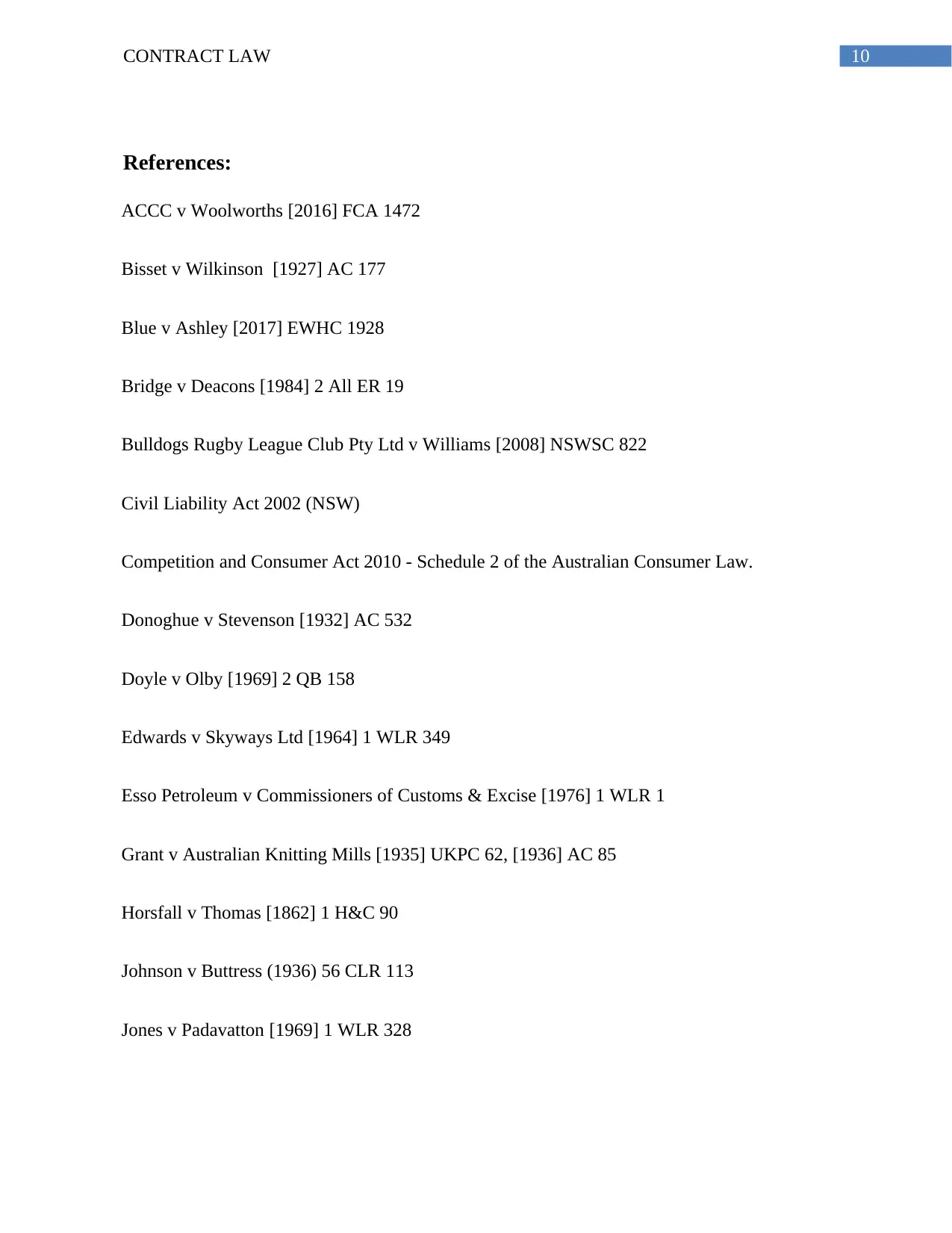
10CONTRACT LAW
References:
ACCC v Woolworths [2016] FCA 1472
Bisset v Wilkinson [1927] AC 177
Blue v Ashley [2017] EWHC 1928
Bridge v Deacons [1984] 2 All ER 19
Bulldogs Rugby League Club Pty Ltd v Williams [2008] NSWSC 822
Civil Liability Act 2002 (NSW)
Competition and Consumer Act 2010 - Schedule 2 of the Australian Consumer Law.
Donoghue v Stevenson [1932] AC 532
Doyle v Olby [1969] 2 QB 158
Edwards v Skyways Ltd [1964] 1 WLR 349
Esso Petroleum v Commissioners of Customs & Excise [1976] 1 WLR 1
Grant v Australian Knitting Mills [1935] UKPC 62, [1936] AC 85
Horsfall v Thomas [1862] 1 H&C 90
Johnson v Buttress (1936) 56 CLR 113
Jones v Padavatton [1969] 1 WLR 328
References:
ACCC v Woolworths [2016] FCA 1472
Bisset v Wilkinson [1927] AC 177
Blue v Ashley [2017] EWHC 1928
Bridge v Deacons [1984] 2 All ER 19
Bulldogs Rugby League Club Pty Ltd v Williams [2008] NSWSC 822
Civil Liability Act 2002 (NSW)
Competition and Consumer Act 2010 - Schedule 2 of the Australian Consumer Law.
Donoghue v Stevenson [1932] AC 532
Doyle v Olby [1969] 2 QB 158
Edwards v Skyways Ltd [1964] 1 WLR 349
Esso Petroleum v Commissioners of Customs & Excise [1976] 1 WLR 1
Grant v Australian Knitting Mills [1935] UKPC 62, [1936] AC 85
Horsfall v Thomas [1862] 1 H&C 90
Johnson v Buttress (1936) 56 CLR 113
Jones v Padavatton [1969] 1 WLR 328
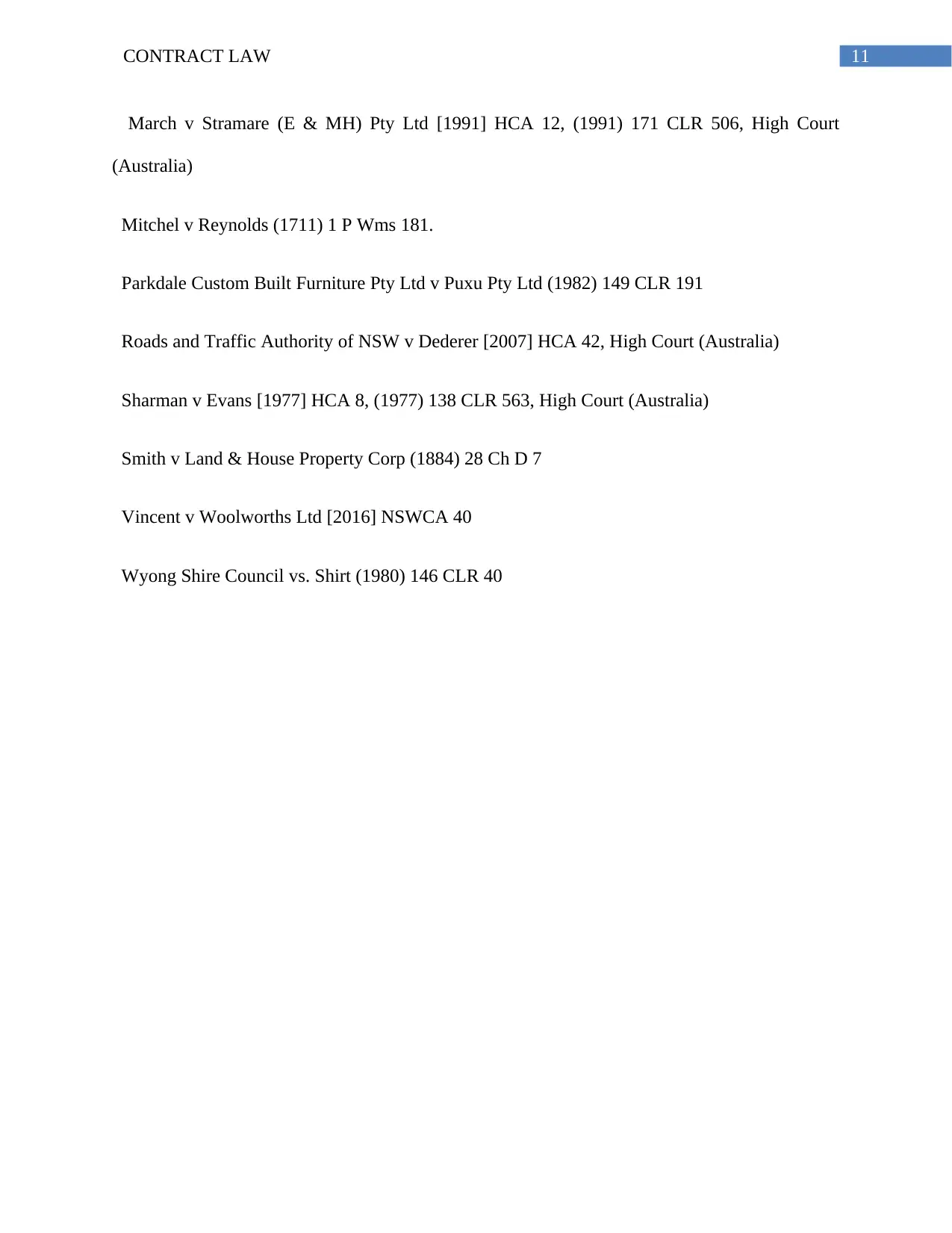
11CONTRACT LAW
March v Stramare (E & MH) Pty Ltd [1991] HCA 12, (1991) 171 CLR 506, High Court
(Australia)
Mitchel v Reynolds (1711) 1 P Wms 181.
Parkdale Custom Built Furniture Pty Ltd v Puxu Pty Ltd (1982) 149 CLR 191
Roads and Traffic Authority of NSW v Dederer [2007] HCA 42, High Court (Australia)
Sharman v Evans [1977] HCA 8, (1977) 138 CLR 563, High Court (Australia)
Smith v Land & House Property Corp (1884) 28 Ch D 7
Vincent v Woolworths Ltd [2016] NSWCA 40
Wyong Shire Council vs. Shirt (1980) 146 CLR 40
March v Stramare (E & MH) Pty Ltd [1991] HCA 12, (1991) 171 CLR 506, High Court
(Australia)
Mitchel v Reynolds (1711) 1 P Wms 181.
Parkdale Custom Built Furniture Pty Ltd v Puxu Pty Ltd (1982) 149 CLR 191
Roads and Traffic Authority of NSW v Dederer [2007] HCA 42, High Court (Australia)
Sharman v Evans [1977] HCA 8, (1977) 138 CLR 563, High Court (Australia)
Smith v Land & House Property Corp (1884) 28 Ch D 7
Vincent v Woolworths Ltd [2016] NSWCA 40
Wyong Shire Council vs. Shirt (1980) 146 CLR 40
⊘ This is a preview!⊘
Do you want full access?
Subscribe today to unlock all pages.

Trusted by 1+ million students worldwide
1 out of 12
Related Documents
Your All-in-One AI-Powered Toolkit for Academic Success.
+13062052269
info@desklib.com
Available 24*7 on WhatsApp / Email
![[object Object]](/_next/static/media/star-bottom.7253800d.svg)
Unlock your academic potential
Copyright © 2020–2025 A2Z Services. All Rights Reserved. Developed and managed by ZUCOL.





